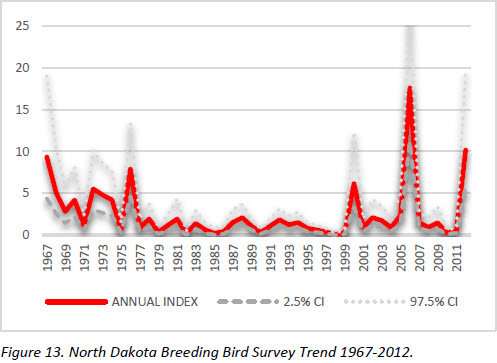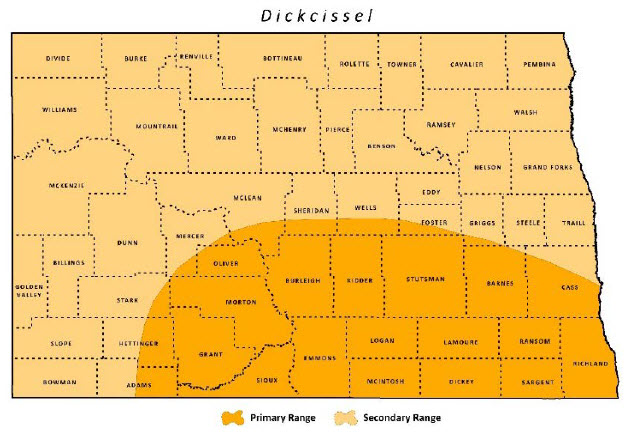
Dickcissel
| Scientific Name | Spiza americana |
|---|---|
| General Description | L 6.25”, WS 9.75”, 0.95 oz. Yellow breast, rufous shoulders, and a distinct black “V” on throat. |
| Status | Occurs in North Dakota from June to August. Peak breeding season early June to mid-August. |
| Abundance | Fairly common to uncommon. |
| Primary Habitat | Alfalfa, sweet clover, hayland and other brushy grasslands. |
| Federal Status | Migratory Bird. |
| Reason for Designation | Threats may occur primarily on wintering grounds in South America where millions of birds are thought to die each year due to poisoning on agricultural lands. It is included on the National USFWS Birds of Conservation Concern list, and also in BCR 11 and 17. Partners in Flight (PIF) identifies the Dickcissel as a Regional Concern Species. |
Locations and Conditions of Key Habitat
Preferred Habitat
Dickcissels use a variety of grassland habitats with dense, moderate to tall vegetation and moderate litter depth. Old fields, hayfields, fencerows, hedgerows, road rights-of-way, CRP, DNC, or moderately grazed and idle prairie are utilized. Forbs also required for perching, nesting cover, and possibly increased invertebrate abundance. Nests are most often built above ground in tall grasses, forbs, shrubs, or trees but may also nest on the ground. Forages on the ground for seeds and insects.
Key Areas and Conditions for Dickcissel in North Dakota
No specific sites have been identified. The Dickcissel is seminomadic and its distribution and abundance varies annually in North Dakota.
Problems Which May Affect this Species
Habitat
The lack of burning, mowing, or grazing can affect suitable Dickcissel habitat by allowing for secondary succession. CRP is an important breeding habitat. It has been predicted if all CRP in North Dakota were converted to cropland, the number of Dickcissels would be reduced by about 17%.
Other Natural or Manmade Factors
Frequently and intensively parasitized by brown-headed cowbirds. In their wintering range of Venezuela, Dickcissels are poisoned when feeding on agricultural fields. Roosting birds are illegally sprayed with organophosphate and organochlorine pesticides, causing massive mortality. Some mortality from collisions with communication towers.
Research and Survey Efforts
Current Research or Surveys
- Currently nothing specific to the species in North Dakota.
Previous Research or Surveys
- University of Montana (ND SWG T-1-R) developed breeding bird models which link population density to local and landscape habitat features in the Prairie Pothole Region of North Dakota. Dickcissel was one of 16 grassland bird focal species. The project was initiated in 2002, a final report was provided in 2004 and dissertation in 2007. Density of Dickcissels was 3-5 times greater in hayland than grassland, and Dickcissels increased in abundance following tree removal from grasslands. (Naugle 2005, Quamen 2007).
- Little effort has been applied to research or surveys specifically for Dickcissels in North Dakota. Several studies which include Dickcissels and other grassland or shrubland associated species have taken place in North Dakota. Examples include the benefits of CRP to grassland nesting passerines, and the effects of various management practices.
- Numerous published reports and gray literature on this species throughout its range.
Additional Research or Surveys Needed
- Determine the effects of contaminants or insecticides on prey species.
Population and Trend Estimates

- PIF Global Population Estimate: 20,000,000
- PIF North American Population Estimate: 20,000,000
- PIF North Dakota Population Estimate: 170,000
- North Dakota BBS Trend: see figure 13
- Survey-wide BBS Trend 1966-2012: -0.55
Management Recommendations
- Protect and maintain grasslands.
- Minimize disturbance to suitable habitat during nesting season.
- Allow litter to accumulate, for example, burn CRP fields less frequently (every 3 years).
- Avoid simultaneous disturbance at the same site (i.e. grazing and burning or grazing and haying during the same year).
- Establish grassy filter strips along fields and existing edges.
- Burn or mow grasslands on a 3-5 year rotational basis.
- Remove trees from grassland, do not establish shelterbelts in grassland.
- Delay mowing until after peak nesting period but do not mow later than mid-September so vegetation can recover.
- Allow retired agricultural fields to undergo secondary succession, however, when succession advances to the point unsuitable for Dickcissels, implement burning or grazing.
- Construction of communication towers should follow the guidance of “Service Interim Guidelines for Recommendations on Communications Tower Siting, Construction, Operation, and Decommissioning” and American Bird Conservancy Collision Program framework.
Monitoring Plans
According to the Partners in Flight Landbird Conservation Plan, long-term population trend monitoring such as the Breeding Bird Survey is generally considered adequate, but may not account for some issues (e.g. bias). Ensuring all BBS routes are conducted annually is priority. Future monitoring proposals should follow recommendations North American Bird Conservation Initiative ‘Opportunities for Improving Avian Monitoring’.
2005-2015 Progress
The Dickcissel remains a Level II Species of Conservation Priority. Several State Wildlife Grant Projects ( T2-11-HM, T-18-R, T-20-D, T-21-D, T-22-HM, T-23-HM, T-25-HM, T-28-L, T-37-D) have contributed to habitat enhancement grasslands for Dickcissel and other grassland dependent birds.

Note: A listing of works consulted when compiling the information on this page may be found in the 2015 State Wildlife Action Plan.
